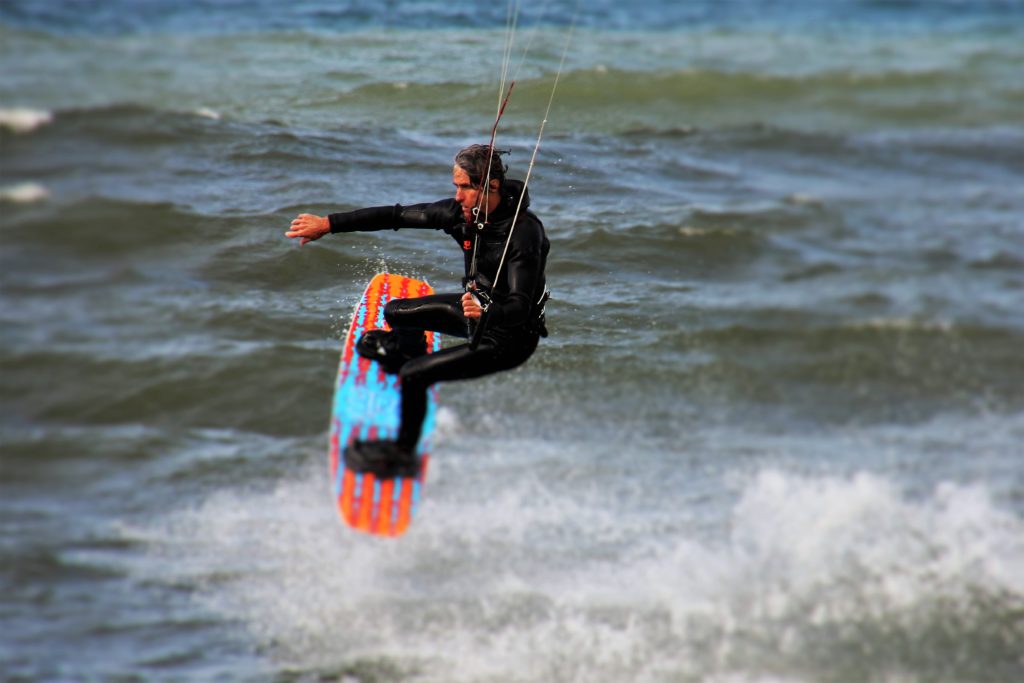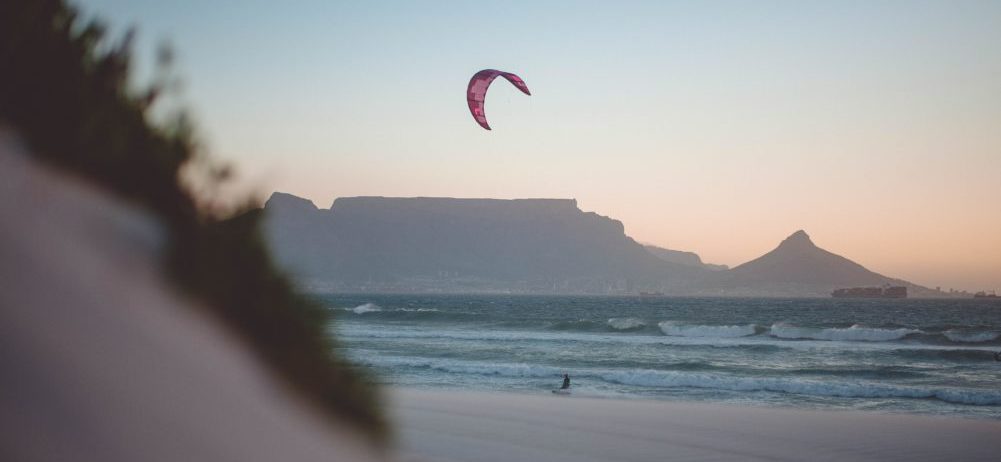I can’t think of any other sport when the thrill of water and air comes to my mind; kiteboarding! The day I read about this sport made me overwhelmed and anxious. Later, I took proper training, learned about the correct equipment used, some tricks, some flips. And, today I am a free bird in the air, splashing through the water, relishing every moment of it.
It’s awesome that you are reading this page to know more about kiteboarding and experience the all-time craze. Best part is, you will surely take the next step towards the sport after you have finished reading through this article, with a happy face to beat!
What Is Kiteboarding
 Kiteboarding, otherwise called as kitesurfing, is a sport which uses a surfboard, a kite (like a parachute), to make the rider drive across the water with the flow of wind. The sport is not limited to ocean waves, can thoroughly be enjoyed on still waters also. The only factor important is the wind and its power. So just choose a location with beautiful waters and breezy climate and you are sorted!
Kiteboarding, otherwise called as kitesurfing, is a sport which uses a surfboard, a kite (like a parachute), to make the rider drive across the water with the flow of wind. The sport is not limited to ocean waves, can thoroughly be enjoyed on still waters also. The only factor important is the wind and its power. So just choose a location with beautiful waters and breezy climate and you are sorted!
It’s all about how you take off from the waters and land. The inflatable tubes in the kites help in producing the traction from the wind and pull the power from it. That makes the kite be able to float in the air for a longer duration as well as allowing a soft landing on waters and the subsequent easy relaunch.
A myth existed earlier stating that kiteboarding is only for people with strength and body power. Let’s get it straight- Anybody can do kiteboarding by choosing the correct kite, board and knowing the technique to steer. No gym classes necessary to build muscle power just to learn this sport, you can trust me on that. Indeed, even if you are a beginner, there are kiteboarding kite for beginners that you can choose from too!
When we talk about kiteboarding, it has various activities combined in it, some of which are snowboarding, wakeboarding, paragliding, windsurfing, sailing, and skateboarding. So, your level of fun will depend on what approach you want to take.
Remember to choose kiteboards that are proportional to your size!
Types/Styles of Kiteboarding
When we say styles, it refers to the different kind of techniques we use when we are kiteboarding. From beginners to experts, all these types are learned and enjoyed by them.
- Freeride: This is one of the most popular styles which allows us to do anything with the sport. Any technique, whether to be a professional or just for fun, freeride is just the thing you will want. Most of the kiteboards nowadays are designed for freerides. It gives you the freedom to move along with the wind!
- Freestyle: This kind is meant for people who enjoy most of the time in the air. Being airborne, cool tricks can be tried in freestyle. Helps both beginners and professionals to enjoy and be competitive at the same time.
- Wave-riding: This is a combination of kiteboarding and surfing. As the name suggests, the main factor involved here is waves. So, a location with waves or wave-break is a must for this style. While being on top of the waves, the rider can use the board and turn directions, taking small to big leaps. Usually, a kiteboard without foot straps is used in such styles which allows the rider to move their foot position on the board according to the flow and force of water.
- Wake-style: On the contrary to wave-riding, wake-style is best fit for still/flat waters. This is a style, very popular among young riders due to its easy techniques and less water power needed. Since there is a lack of current, most of the tricks are aerial based.
- Wake-skate: Best in flat waters and use of twin-tip boards with no straps are preferred.
- Course-racing: If it’s a race, then speed will be the winning factor here. Most events are organized, where riders take part using their long tip boards or sometimes foil-boards also and compete with other riders in the flow of water. Specially designed directional kiteboards are the best for this style.
- Park-riding: This involves wakeboarding with obstacles, to perform difficult stunts. Preferred by professionals to exhibit their skills in a larger platform.
4 popular types of kiteboards

There are various kiteboards out there, and each of them has its own specific purpose. Let us take a closer look at the different types of kiteboards that you can see in surf schools as well as in the market.
- The Twin-Tip kiteboard: This is the most common and used type of kiteboard as it is flexible for all kinds of kiteboarding activities. Comprises of foot-straps and looks like a conventional wakeboard. It has a concave bottom side, which allows channeling the water in a specific direction, thus getting chances of higher speed. Available in flat, medium and high rocker types.
- The Light Wind kiteboard: The idea is being able to manage the sport even when the power of wind is not great. That’s where the Light Wind kiteboard steals the show. Rectangular in size, this board provides a lot of surface area, with enough grip. Light in weight and broader in surface, this type is very popular among heavy weighted riders. Less drag-more lift is the style this board conceptualizes.
- The Kite-Surf board/Wave kiteboard: The ideal choice for riders who want to float in the air, chase the waves or maybe just relax sailing like a cruise. It has an epoxy core, with thinner and smaller size as compared to a standard shortboard. Popular shapes in the market are diamond nose shapes and diamond tail shapes.
- The Foil board: The board has great speed, which really allows you to fly in the water at high speeds. My personal favorite, this board provides less drag and more airlifts. Its wing is designed using hydrodynamics concept, making it best for choppy waters. Less physical effort is required due to the hydrofoil which enables quick turns and great uplifts.
Guides To Avoid Mistakes In Kiteboarding
For anyone to enjoy the thrills of the sport, one needs to avoid the common mistakes. Else the whole fun will come down to a nasty accident. Let’s go through some of the basic rules to follow for a seamless experience.
Follow Rules And Regulation
Any beach you choose for kiteboarding, always ask the beach guide about the kiteboarding rules on the beach, areas prohibited on the water spot for surfing, etc.
Ensure Harness Integrity Is Intact
Always ensure that you adjust your harness to suit your need. It should be positioned correctly and tightened. While airborne, if the kite becomes loose, make sure to land on the water, adjust the harness properly and relaunch.
Avoid Tangles
Make sure to have a good lines management for the kite. If dragged along on the beach for a longer time, they will get entangled and you surely don’t want this to happen. An entangled kiteboarding kite will not be easy to control too.
Grip On Bar
Have a good grip on the bar while holding your kite. Bar control will not only help you in controlling the kite but also direct your board in the right direction.
Avoid Oversteering
Don’t oversteer. This is not a good tactic for kiteboarding because it changes the flow in air abruptly and the landing turns out to be messy and sometimes dangerous.
Self-recovery
While you are in the air, the only person that can help you when you are in need is actually yourself. Hence, you should learn the technique of self-rescue before getting into the sport. Now when you are in the waters or air, no matter how many people there are to guide you, you are the only person who can save yourself when a sudden situation occurs. Learning the correct technique is foremost.
Go Deep
Go into the waters till you reach a safe distance from the sand and then launch your kite after stepping on your board. This step will allow the board not to get stuck on the shore sand. Also, having a good distance from the shore allows you more room to do your tricks and get the attention from others!
Know How To Land
The safe way to land is by the leading edge of your kite. Stick to the process of landing and avoid trying stunts at that moment. Only start to do the tricks when you have mastered the technique of landing without hurting yourself.
When it comes to landing the kite, don’t pull the bar so hard as it will make the process more difficult and might result in dragging yourself when the helper grabs the kite.
Once the helper grabs the kite, leave the bar and start walking slowly towards the kite, so that the entire recoveryis completed smoothly.
Summary
A sport filled with joy, thrill, speed, water, and air, Kiteboarding is the showstopper. Gone are those days where water sports were limited to swimming and snorkeling. With the right skills, techniques and a push of passion, you can become a kiteboarder. Make sure to consult the appropriate training team to guide you through all the steps, help you select the right equipment and the spot to carry out the sport. And now that you have read through the entire article, you have some basic idea of kiteboarding, its features, types, and precautions to take. Make your own bullet list and rush to your nearest outlet of water sports. Nowadays, the companies retailing the equipment also provide contacts for the best available training instructors. You can directly have a chat and choose wisely. Learn, master and have fun.
Be it a beach party or a race board, you can rejoice at every occasion. Always remember, it’s never late to get involved in this wonderful sport.
All the best for your kiteboarding experience, and be ready to grab the attention with your tricks!

